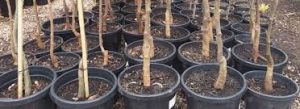Frangipani are small trees and their perfumed flowers are evocative of the SE Queensland subtropical environment. Most common are the deciduous varieties. At this time of year they are relatively dormant and any branches that have been pruned to restrict size can be used to create new plants.

Branches as small as 100-150mm can be left in a dry place for a week or two for the cut ends to seal and dry.
Ensure cuttings are potted in a stable size container of free draining potting mix and supported well. Place in a warm area of the garden and water sparingly. They can be planted out once roots have formed.
As part of the winter cleanup, if there are still fallen frangipani leaves on the ground, ensure they are collected and placed in a household rubbish bin, to reduce incidence of re-infection with frangipani rust.

Like Frangipani, Citrus (below) don’t generally require a lot of pruning, but now is a good time to formatively prune for shape and size and remove dead and unhealthy wood. This includes swellings caused by the gall wasp.

Another winter task for your lawn is not to forget that now is the time to attack Bindii. If you wait until prickles form, it’s too late to save your your feet during the summer months. It is simple to check the lawn for the low-growing rosettes of carrot-like foliage (below). In some circumstances single plants can be dug out by hand, but larger infestations may require a selective spray. Clover can also be a particular problem at this time of year, but be mindful that the bees use this as a good source of nectar. Ask at your local garden centre for suitable control products.
